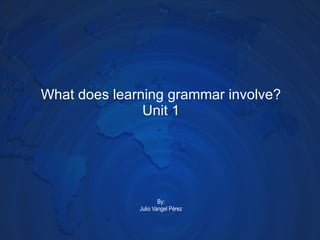What does learning grammar involve? and the organization of grammar teaching
•Als PPT, PDF herunterladen•
2 gefällt mir•3,738 views
Melden
Teilen
Melden
Teilen

Empfohlen
Empfohlen
Weitere ähnliche Inhalte
Was ist angesagt?
Was ist angesagt? (20)
Andere mochten auch
Common difficulties and solutions in teaching English as a foreign languageCommon difficulties and solutions in teaching English as a foreign language

Common difficulties and solutions in teaching English as a foreign languageDr. AbdulRahman M. Gadah Al Madinah University, Educational Office of East Makkah
Andere mochten auch (8)
Common difficulties and solutions in teaching English as a foreign language

Common difficulties and solutions in teaching English as a foreign language
Ähnlich wie What does learning grammar involve? and the organization of grammar teaching
Ähnlich wie What does learning grammar involve? and the organization of grammar teaching (20)
Губарєва С. С. Ефективні шляхи презентації англійської граматики (5-6 класи)

Губарєва С. С. Ефективні шляхи презентації англійської граматики (5-6 класи)
Summary of the most important methods presented in class

Summary of the most important methods presented in class
English Language Teaching Frameworks - Yasmina Zergani.pptx

English Language Teaching Frameworks - Yasmina Zergani.pptx
TEACHING GRAMMAR Abdelaziz Elallouchi -Said Sefart.pptx

TEACHING GRAMMAR Abdelaziz Elallouchi -Said Sefart.pptx
Mehr von juliovangel
Mehr von juliovangel (12)
What does learning grammar involve? and the organization of grammar teaching
- 1. What does learning grammar involve? Unit 1 By: Julio Vangel Pérez
- 3. Form: This refers to the how the language, is structured, meaning that the student must understand the sentence structure of a specific grammar rule. In this example on the past perfect tense, it would be: subject | had | past participle | object/complement. Meaning: This is the comprehension that is generated by grammar. Students connect the grammar structure with the meaning. For example, the past tense signals events in the past, the past perfect signals earlier actions/events in a narrative. Once the teacher has presented the structure, he should mention the meaning too. Use: Finally comes how the grammar gets used. For example, the past perfect tense isn't used in every sentence but rather in conjunction with the past tense. One sentence appears in the past perfect to order events, and then subsequent sentences appear in the simple past. Take the following short narrative: Tom had studied English for ten years. As a result, he got a great job in England last year.
- 4. 1: Keep the explanations brief. A simple comment that the past tense refers to events in the past serves as an adequate explanation. The same holds true of a few comments on the past perfect, or any other structure. A visual diagram and several examples also further highlight the target language. 2: Limit the explanation to the task/lesson at hand. There may be several exceptions to the rule. There may be times when the language isn't used for some situation or with some medium. Yet this is all extraneous information. The teacher wants to provide just enough explanation for the students to practice the language correctly and purposefully. 3: Consider devoting several lessons to a specific grammar or language point. This allows the teacher to address and practice the rules and exceptions, yet not overwhelm the class with too much information. The teacher can also practice different skills/mediums, yet return to the same language point. 4: Address grammar and vocabulary again and again. The teacher should provide several opportunities to acquire the target language during a course of study. Just because students have studied the target material once doesn't mean they can use it well. By revisiting the target structures, then students who grasped the form have a second chance to grasp the meaning and use of the target structure. Students who grasped the meaning have a second chance for the form and use. Recovered from: http://www.betterlanguageteaching.com/esl-articles/89-form-meaning-use February 15th 2010
- 5. Aspects of the teaching/learning of structures *It’s very important to never isolate activities; keeping a balance and linking grammar with the linguistic skills, will give the student a sense of direction in the language. Form Meaning Listening Perception and recognition of the spoken form of the structure. Comprehension of what the spoken structure means. Speaking Production of well-formed examples in speech. Use of the structure to convey meanings in speech. Reading Perception and recognition of the written form. Comprehension of what the written structure means in context. Writing Production of well-formed examples in writing. Use of the structure to convey meanings in writing.